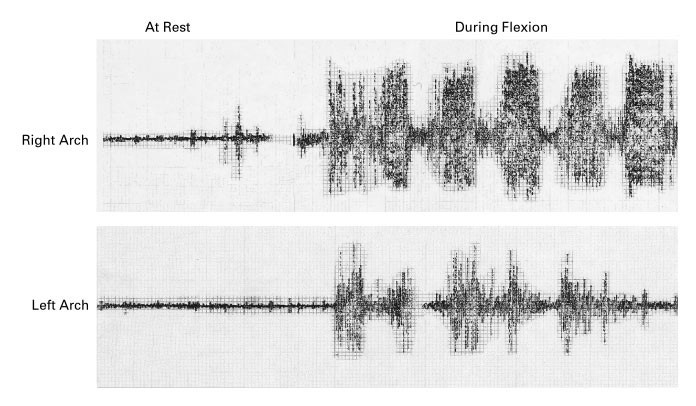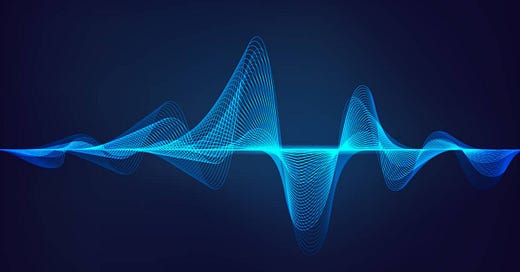Band Tension in Strength Training Part 2: Resonance
Expanding Band Tension in Strength Training: From Nervous System Development to Connective Tissue Adaptation Through Resonance.
Recap: The Genesis
In Part 1 of this series, we explored Louie Simmons’ innovation of putting bands overtop of barbells—a strategy that revolutionized strength training by scaling the central nervous system1 (CNS) of his athletes—powerlifters. This training innovation led to never before seen gains in absolute and speed strength, which cemented Westside Barbell as the strongest and most dominant barbell club the world has ever had.
A New Training Paradigm
While the neurological benefits of band tension are well known, there is another application that has yet to receive the attention it deserves. In part two, we will move beyond the what we term the neurological paradigm of utilizing band tension in the traditional Maximal Effort and Dynamic Effort Methods to explore how band tension can be utilized to rehabilitate2 and train the bottom up biological element of reactive strength: connective tissue.
For too long, band tension has been viewed primarily through the lens of neurological strength development—strength-speed, speed-strength, explosive-strength, etc.3 Our intent is to push the boundaries of conventional thinking and explore how band tension can play a specific role in developing the bottom-up element of reactive strength. Specifically, we will explore how band tension can stimulate the development of architectural organization, reactivity, stiffness, elasticity, and force transmission abilities of the connective tissue network.
By embracing this new perspective, we break new ground and introduce a fresh paradigm4 in which strength practitioners take a more active role in the prevention, rehabilitation of reactive strength injuries as well as the long-term development of reactive strength.
Band Tension → Load → Resonance
Band tension creates a unique form of load that carries with it resonance, a dynamic wave of energy that propagates through the connective tissue architecture. Unlike static weight, which provides consistent resistance and thus consistent resonance, bands are dynamic and challenge the trainee throughout the entire range of motion, forcing the neurology to adapt and respond. Part of our thesis is that this resonance from the bands enhances communication between the connective tissue and the CNS, leading to a more comprehensive and potent training stimulus.
Resonance: Afferent Information Flow
Healthy connective tissue generates a natural resonance that the CNS interprets as normal. However, when there is dysfunction or injury in the tissue, this resonance changes, prompting the CNS to respond differently—this is where we observe the phenomenon of neurological tightness. These changes in resonance from abnormal tissue, as seen in the image below, directly impact the nervous system's behavior, impacting movement and force output.5

Resonance: Afferent Information Flow (A Feeling) From the Connective Tissue to the CNS
A physiological concept, often overlooked in Training Science, is that when connective tissue is healthy, the resonance it generates feels normal to the athlete. However, when the tissue is injured or abnormal, it produces a different resonance. This altered wave pattern is detected by local mechanoreceptors and encoded into the nervous system, allowing the athlete to feel the feeling of the abnormality in their connective tissue architecture.
The nervous system interprets the resonance waves within the connective tissue to assess the tissue's physical state.6 By understanding this, we can appreciate how resonance facilitates information flow both locally at the tissue level and globally within the nervous system. This localized information flow is a primary factor that enables the CNS to fully actualize its force output potential in maximal effort and dynamic effort training scenarios.
Let's dig into the physiological details of what happens during these training scenarios and in doing so we will better understand how band tension can behave as a potent stimulus for the bottom up element of reactive strength.
Neurology & Resonance: CNS Cannot Distinguish Between Band Tension Resonance and Connective Tissue Resonance
From our experience, we believe that utilizing the Maximal Effort or Dynamic Effort methods with band resistance allows trainees to fully actualize their neurological potential.7 Any strength practitioner who has applied these training methods with bands over the barbell has experienced how powerful a stimulus bands are for developing the neurological network responsible for absolute strength—the central nervous system (CNS). But what makes bands such a potent training tool? Let’s explore.
It is well established that the CNS does not always differentiate between where its biology ends and the external world begins.8 To illustrate this, let’s use the example of a hockey player. As the player practices stick skills, the external object—the hockey stick—starts to become integrated into the CNS. Even though the player's consciousness knows the stick is not part of their body, the neurological network of strength responsible for control and coordination does not. The more and better the stick becomes encoded into the neural network responsible for control and coordination, the better the emergence of skill in sport-specific hockey movements.
Now, let's transition the example into another sport—powerlifting. Lou’s innovation of using bands over barbells revolutionized training for his sport. When training with a barbell, that barbell becomes encoded into the nervous system in much the same way as the hockey stick in the previous example. If the barbell is loaded only with static resistance—just plates—the nervous system can quickly stagnate, especially in individuals with a high level of neurological training adaptation.9 This neurological stagnation leads to coasting at the end of repetitions, which results in a decrease in neurological force output—the exact opposite output we want from this training.
However, when chains or bands10 are added to the barbell, the nervous system is stimulated to produce force throughout the entire range of motion. This eliminates the problem of neurological stagnation and prevents any neurological coasting, ensuring continuous maximal or dynamic effort in every phase/posture of the lift. Let’s continue to unpack how the nervous system cannot distinguish the resonance created by the band vs the resonance created by its own connective tissue.
Chains Are For the 1990s
Louie often told me, "Chains are the '90s, and bands are the future," and anyone who's trained with barbells using static loads will quickly realize why after adding bands to their training. Chains do accommodate resistance and alter the force-posture curve of the lift, but they still involve static weight.11 It is our thesis that this static load generates a form of resonance that causes the nervous system to hold back to some degree and not fully unleash in force output training scenarios.
For example, lifters need to be coached and encouraged to be aggressive with the barbell during both the reversal (transition) and concentric phases of the lift. There’s also a natural hesitancy to "drop the barbell" quickly during the eccentric phase when using static weight. Bands, however, remove these limitations. The tension generated by band resistance creates a resonance of afferent information that propagates into the CNS, eliminating any neurological constraint on force output. This allows the lifter to push their neurology to its full potential, sometimes pushing the connective tissue beyond its biological limitations. Without proper coaching or a training partner to regulate the effort, the nervous system can scale force output to a level that becomes too chaotic for the connective tissue responsible for force transmission, potentially leading to tissue failure.
A prime example of injury occurred with the Green Bay Packers this past offseason when multiple players and their head coach ruptured connective tissue of their pectoral muscles while training dynamic effort bench press—a feat that if you asked us if this possible, we would say zero chance. But as Einstein said, "There are limits to intelligence but no limits to stupidity."
Actualizing Neurological Potential Into Reality
Why do you feel the unconstrained effort of the CNS when training with bands? Our belief is that the CNS cannot distinguish between the resonance generated by band tension and that of the body's own connective tissue.12 While the trainee knows that the bands are external, the CNS interprets the resonance from the bands in the same way it perceives natural tension within the connective tissues. In contrast, the CNS can differentiate the resonance of static loads, as the signals it receives from static weight lack the dynamic resonance of band tension.13
This inability to distinguish between band tension and internal tissue tension creates a unique training scenario. When properly coached, athletes can fully unleash their force output, allowing their neurology to actualize its potential in real-world performance—which exactly what was observed at Westside Barbell when they pioneered the use of band tension in training while at the same time putting the sport of powerlifting in a complete stranglehold.
Training Example: Neurological Potential Realized
Let’s take a dynamic effort trap bar training as an example. There’s the static weight of the trap bar and plates, but there’s also band tension involved. When the trainee locks into the starting posture, they will first eliminate any slack14 in their body, then drive force through the ground until their hips reach the end position. During this repetition, the force posture curve is altered—rather than generating an impulse of force at a specific position and then coasting—which is what occurs with static weight, the lifter must continually output force to accelerate through the entire range of motion. Once the repetition reaches the top, the trainee’s CNS feels a stronger resonance from the bands, but cannot differentiate this from the body’s own connective tissue tension. This is where we observe that the CNS does not know that the bands are not its own biological connective and at this point in time the athlete’s neurology will be able to actualize its force output potential into reality.
Let’s continue with this scenario. When coaching dynamic effort, we need to guide the athlete to reach their highest attainable speeds. Think of a repetition like a drag race, with the athlete as the driver. As the repetition begins, the athlete "gasses" their neurological network until the finish line, which in this case is the end of the rep. Just like drag race cars deploy parachutes to slow down, the band tension slows the lifter down at the end of the range of motion. The CNS feels this increased resonance from the stretched bands and perceives it as a safety mechanism, which allows the nervous system to fully unleash maximal and dynamic effort.
This is why, when watching old videos of Westside Barbell powerlifters, you see them violently moving the barbell from Point A to Point B. On dynamic effort days, with a combination of static and dynamic submaximal resistance, the speeds they achieve can seem shocking to the untrained eye. It often times look dangerous, but this is what it looks like when the CNS actualizes its full potential in reality.
Welcome to the New Paradigm
Keep reading with a 7-day free trial
Subscribe to Absolute: The Art and Science of Human Performance to keep reading this post and get 7 days of free access to the full post archives.





